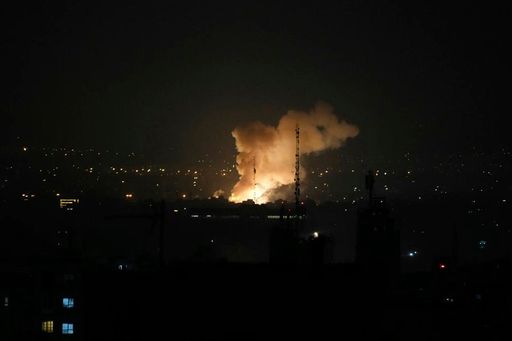As part of its large-scale military operation against Iran on Friday, Israel targeted and allegedly destroyed the Natanz nuclear facility located 300 kilometres south of Tehran.
Officially known as the Shahid Ahmadi Roshan Nuclear Facility since 2012, the Natanz nuclear facility has until now served as Iran’s primary uranium enrichment site.
Iran insists that uranium enrichment – the process of making the element useable as a nuclear fuel – is for peaceful purposes like energy production.
However, Western nations and Israel have made Iran a target of scrutiny, saying it is secretly trying to produce highly enriched uranium for nuclear weapons.
What does the facility look like?
The Natanz nuclear facility consists of three underground buildings and six above-ground structures.
The hidden facilities are more than 131 feet below the ground level. They are protected by a steel and concrete shell, which researchers estimate to be 26 feet thick.
The nuclear material and enrichment equipment in the fuel enrichment plants remain under the safeguards of the International Atomic Energy Agency, a UN body tasked with regulating the use of nuclear energy.
The existence of the Natanz complex was first revealed in 2002 by the People’s Mojahedin Organization of Iran – a dissident group – sparking a diplomatic crisis over the country’s nuclear ambitions.
Since then, it has been at the heart of international efforts to curb Iran’s nuclear programme, including the 2015 Joint Comprehensive Plan of Action (JCPOA), which limited Iran’s enrichment activities in exchange for sanctions relief.

Under the JCPOA, Iran had agreed to cap uranium enrichment at 3.67 percent – a level suitable for nuclear power, but far below the 90 percent needed for weapons-grade material.
The US withdrawal from the JCPOA in 2018 under President Donald Trump allowed Iran to resume and accelerate enrichment.
In renewed talks for a new nuclear deal, Tehran initially showed openness to limiting enrichment levels and stockpile sizes. However, it continues to reject any demands for the dismantling of its nuclear infrastructure, citing its need for civilian purposes.
Under repeated attacks
Natanz has been a frequent target of covert and overt operations by Israel aimed at disrupting the nuclear programme.
The most notable early attack was the Stuxnet cyberattack, discovered in 2010 but likely in development since 2005.
Widely attributed to the US and Israel, the Stuxnet virus damaged nearly 1,000 centrifuges – rotating containers used in uranium enrichment to separate particles from a solution according to their size, shape and density.
Subsequent incidents included a 2020 explosion, attributed to an Israeli-planted bomb, which damaged a centrifuge assembly plant. A blackout in 2021 caused by another alleged Israeli attack disrupted the facility’s power supply and damaged centrifuges.
Israeli attacks on Natanz show its longstanding objective of preventing Iran from building a nuclear arsenal, which Tel Aviv views as an existential threat.
Israel’s actions against Iran are not limited to cyberattacks on nuclear facilities alone. Tel Aviv has frequently targeted nuclear scientists, such as Mohsen Fakhrizadeh, the architect of Iran’s military nuclear programme, who died in a bomb attack orchestrated by Israel near Tehran in 2020.
Tehran also accuses Israel and the US of killing Mostafa Ahmadi Roshan, a key figure in Iran’s nuclear programme in Natanz, in January 2012.
Iran has responded by fortifying Natanz, including constructing deeper underground facilities, reportedly beyond the reach of even US-designed “bunker buster” bombs.
What happened on June 13?
Israeli Prime Minister Benjamin Netanyahu said the strikes were aimed at crippling Iran’s nuclear facilities, including Natanz.
Iranian state media reported multiple hits on Natanz, with heavy smoke billowing from the site, though the full extent of the damage remains unclear.
The IAEA confirmed that Natanz was targeted, but no increase in radiation levels was reported. It suggests that the containment layers protecting Iran’s nuclear stockpile were not breached.

Why Natanz bombing matters
The strikes aimed at disrupting Iran’s ability to produce weapons-grade uranium, a goal Israel has pursued for decades. The Natanz facility is where Iran has produced the vast majority of its nuclear fuel.
While the nuclear stockpile was not directly compromised, the damage to Natanz’s infrastructure could delay Iran’s enrichment activities.
The attack has turned the Israel-Iran conflict from covert operations to overt military action. The killing of senior Iranian military officials and scientists has prompted Iran to vow retaliation. Iran’s supreme leader Ali Khamenei called the attack a “bitter and painful” act, signalling a potential missile or drone response.
As a result, the Middle East may spiral into yet another war, potentially involving the US, which has pledged to defend Israel.
Nuclear deal talks in limbo
The timing of the attack complicates diplomatic efforts to strike a second nuclear deal being mediated by Oman.
Iran’s anger over the attack and the loss of key figures is likely to harden its stance amid threats of destruction by President Trump.
Earlier proposals under discussion included capping enrichment, reducing stockpiles, and enhancing oversight by the IAEA, resembling the terms of the 2015 JCPOA.
In return, Iran seeks the lifting of US sanctions, which have crippled its economy.















